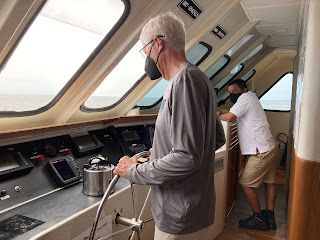The boat motored all night, crossing from the Southern Hemisphere across the equator around the north end of Isabela, the largest of the Galápagos Islands, and then turned south once again, crossing the equator once again from north to south.
About 5 a.m., the boat anchored off Point Espinoza of the island of Fernandia. After breakfast, we dressed for a dry landing and got into the zodiac to explore Fernandia. There were two other boats anchored nearby, both with larger groups than ours, So when all of the zodiacs landed, it was relatively crowded — meaning that we could actually see other people, even if the weren’t usually close enough to talk to.
Fernandia was covered with sea iguanas. There were hundreds of them! They sunned themselves on the black volcanic rock — blending in so well that they were sometimes hard to see.
Many ignored us. Some of the big males made a show of bobbing their heads at us and opening the mouths wide, trying to show their dominance and guard their territory.
Sea lions were also abundant here, and they seemed to coexist with the iguanas without much difficulty. The bright red-orange “Sally Lightfoot” crabs we’ve seen almost everywhere were abundant here, too.
The island is also home to the unfortunately named Blue-Footed Boobie, a bird that actually has blue feet, but is a skilled hunter, diving into the sea like a dive-bomber when it spots tiny fish. Frigate birds, brown pelicans, and flightless cormorants were also using this island for their nests, and were easy for us to see.
The zodiac was late picking us up from the island and returning us to the boat, so we had a quick turn-around to get ready to go snorkeling. Once in our wetsuits, we jumped back into the zodiac and headed quite a distance to a different spot near the shore of Fernandia, where we were going to have the chance to see the sea iguanas actually swimming and feeding.
 |
| A starfish of unique type |
This western side of the Galapagos gets different ocean currents, so the water is both colder and rougher than where we were previously. The wave action stirs up lots of material, so that the visibility is not as good as what we previously experienced. Mary and I were getting along pretty well, so we were a bit oblivious to the fact that a couple other group members were in some distress due to the waves and currents. So, we were a bit surprised when our tour leader abruptly ordered everyone back into the zodiac.
The zodiac took us to a somewhat more protected area behind some rocks, where the sea was not as rough. We re-entered the water, which was just as cold, and the visibility not a great deal better. Several large sea turtles were spotted, so we got to swim with the turtles. We were almost close enough to touch a couple of them, but followed the park rules and restrained ourselves from doing so. Also, a flightless cormorant swam right by us, passing only about a foot away.
Back to the boat once again, we had time for a quick shower before lunch. Meanwhile, the boat revved up its engines and took us southeast, toward Elizabeth Bay of the big island, Bahia Isabel.
At one point the engines stopped unexpectedly and the PA system called us to the front of the boat. Several Bryde Whales were feeding, and we got to watch them as the spouted.
Immediately following the impromptu whale watching, we were allowed, in small groups of three or four, to visit the bridge. The captain explained the GPS, radar, and other navigation aids, as well as the engine controls. We each got the opportunity to steer the boat, which is harder than it looks. The helm does not respond as immediately as in a car or airplane, so it’s easy to wind up with a serpentine course.
As soon as the boat anchored in Elizabeth Bay, we dressed for a long zodiac ride. There was no landing on shore, but we were able to closely observe boobies, sea lions, pelicans, and for the first time, Galápagos penguins, possibly the only species of penguins that lives and thrives in a tropical climate.
The zodiac took us into a mangrove forrest along the shoreline, a very still and protected channel of water, where we saw many turtles swimming, many coming right up to the side of the boat, completely unperturbed by our presence. The zodiac expedition became a bit longer than necessary, and we got pretty hot in the afternoon sun.












No comments:
Post a Comment